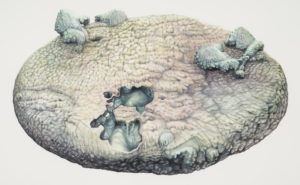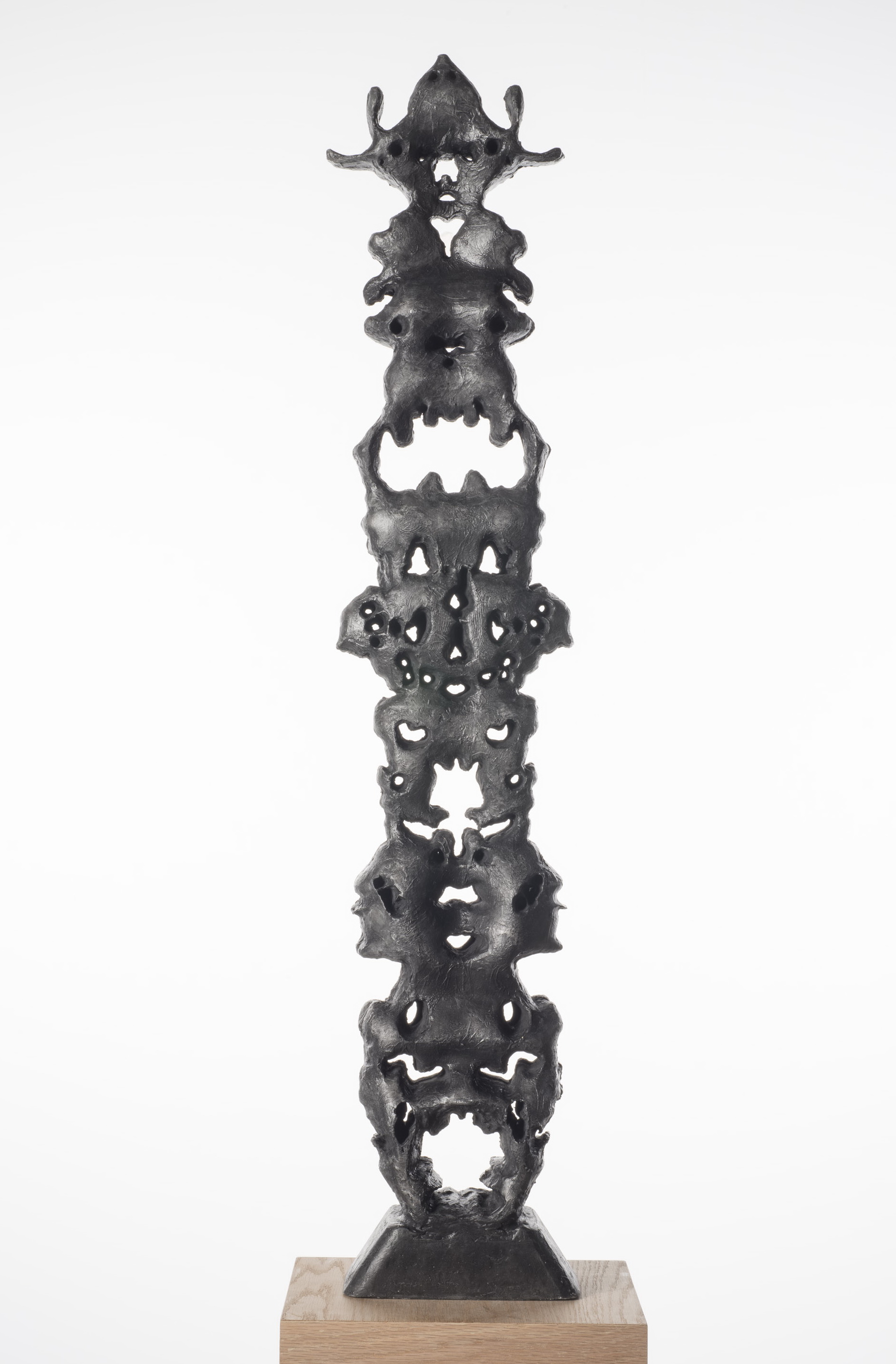Standing erect on pedestals, Colette Robbins’ seven skeletal sculptures twist and bend like limbs, frown and gape like skulls, and yet they are clearly not figurative. Rather, the ethereal totems coax the mind to create fiction from their abstract forms.
“Archaeological Fiction” is the New York-based artist’s first exhibition in Los Angeles, featuring her latest experimentation with the Rorschach inkblot as a gateway for the phenomenon of pareidolia (the human psyche’s attempt to make sense of the abstract). While Robbins previously created inkblot narratives of bicephalic monoliths, “Archaeological Fiction” delves into more subjective territory. Similar to Micah Ganske’s project at 101/Exhibit, “The Future is Always Tomorrow” (2015), Robbins mediates between reality and the viewer’s imagination with 3D printed sculptures; she produces totems from her inkblot designs, finishing them off with coats of graphite powder or acrylic paint. Agenticity (all works 2016), a tall totem glistening with graphite, suggests a stack of alien pelvises squeezing a toothy jack-o’-lantern face. By contrast, its neighbor, Pareidolia, is a petite totem with pitted acrylic skin, reminiscent of a tree made out of ears and a pair of testicles for a trunk. Whereas Ganske’s sculptures provided tactility in his virtual reality installation, Robbins uses the 3D printer to transform the perception of inkblots and enhance the experience of pareidolia.

Colette Robbins, Slippage, 2016, courtesy of Larry Underhill and 101/Exhibit Gallery, Los Angeles.
Robbins additionally mines for abstraction from a more organic source, her rock collection. She extracts imaging of their unique contours and shapes, digitally overlays them with her inkblots, and then paints watercolor and graphite illustrations of crusty, fictitious fossils. While the totems invite the viewer’s interpretation, the watercolors are more self-referential, contributing insight into Robbins’ perceptions of abstraction. One specimen, Tangentiality, seems to depict two ancient arthropods clinging to a smooth, teardrop-shaped stone. Another, Stereotypy, features a trapezoidal formation with a rippling surface bejeweled by crystallized, prehistoric barnacles. These pieces contain hyper-fine details of craters and crevices, complemented by delicate, earthy tones, as if Robbins really did dig them up from a period lost in time and space. Robbins’ rock collection is unobtrusively arranged toward the back of the gallery, contextualizing pareidolia in her work.
Seven small, round peepholes into other dimensions accompany the fossils on the wall. Several of these watercolors conversely feature inkblots subtly incorporated in surreal waterscapes. Rorschach Cave Inside presents a sunset on an ocean horizon perceived through an inkblot-shaped window in the cobbled wall of a cave. In a neighboring piece, Rorschach Cave Outside, Robbins reveals the exterior of this grotto, once again appropriating the gnarled texture of her rocks, partially submerged by lapping green waves. The cave narratives are paired with more abstracted images, such as Rorschach Water Hole, in which Robbins realizes an inkblot as a jagged pit in the middle of a shimmering blue sea.
Although the totems and illustrations were produced with cutting-edge technology, they effectively evoke the prehistoric aesthetic of archaeological artifacts. “Archaeological Fiction” may be derived from Robbins’ imagination, yet in her realization of pseudo-archeology, she simultaneously creates personal artifacts for the future to discover.



















0 Comments